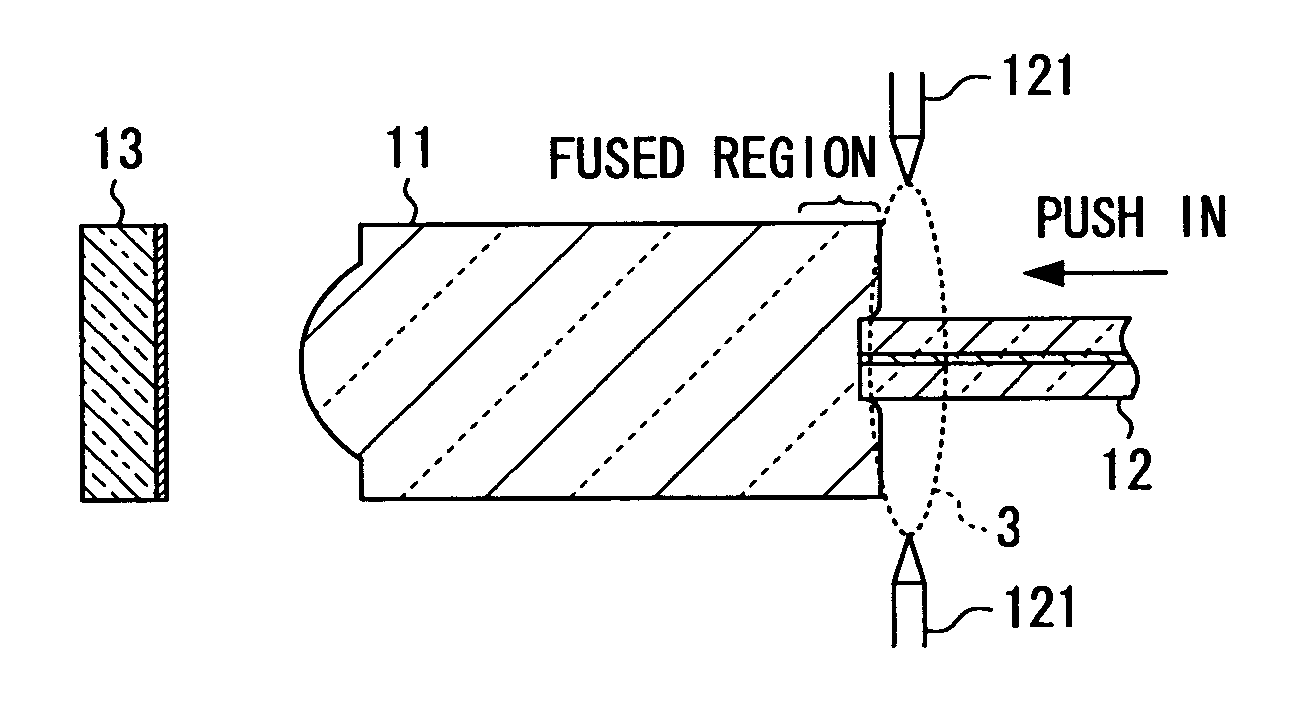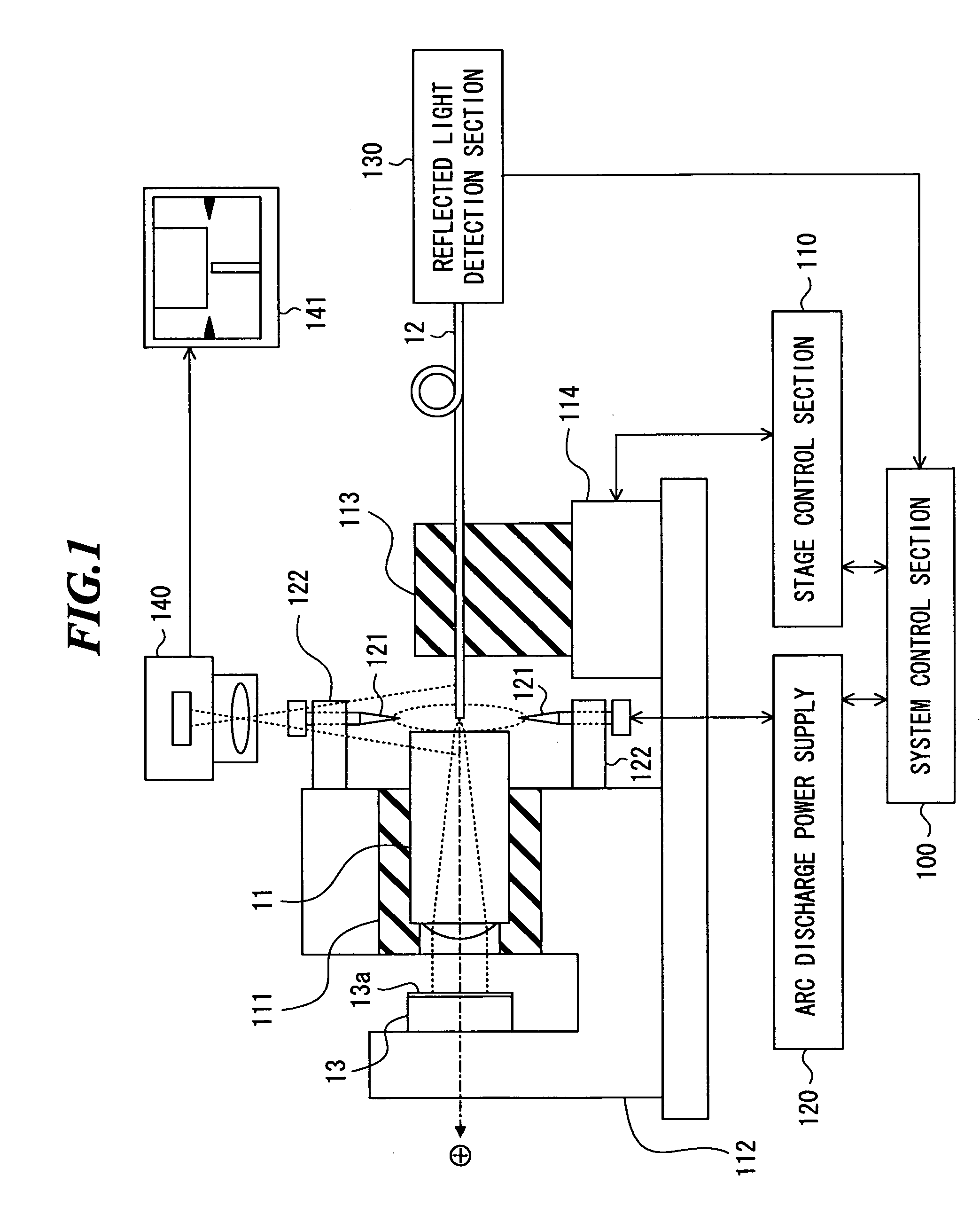Optical device and fabrication method and apparatus for the same
a technology of optical devices and fabrication methods, applied in the field of optical devices, can solve the problems of large number of devices to be used, long assembly time, and complicated fabrication processes, and achieve the effects of reducing fabrication costs, reducing the loss of light at the joint surface, and simple fabrication process
- Summary
- Abstract
- Description
- Claims
- Application Information
AI Technical Summary
Benefits of technology
Problems solved by technology
Method used
Image
Examples
first embodiment
[0044]FIG. 1 is a schematic diagram showing a configuration of an optical device fabrication apparatus according to the present invention. The optical device fabrication apparatus is an apparatus for splicing a first optical device and a second optical device to fabricate a third optical device. In the present embodiment, a lens is used as the first optical device and an optical fiber is used as the second optical device, and thus a fiber collimator is fabricated.
[0045] The optical device fabrication apparatus shown in FIG. 1 includes a system control section 100, a stage control section 110, an arc discharge power supply 120, a reflected light detection section 130, a lens holder 111, a holder 112, a fiber holder 113, a movable stage 114, an arc electrode 121, and an arc electrode holder 122. Further, the optical device fabrication apparatus according to the present embodiment may also include a position observation section 140 and a monitor 141.
[0046] The system control section 1...
second embodiment
[0085] Next, an optical device fabrication apparatus according to the present invention will be described with reference to FIG. 8. The optical device fabrication apparatus shown in FIG. 8 is an apparatus for fabricating a multi-core fiber collimator in which a plurality of optical fibers are connected to one lens. In the present embodiment, the case where a two-core fiber collimator is fabricated will be described.
[0086] Instead of the fiber holder 113 and the reflected light detection section 130 shown in FIG. 1, a fiber holder 213 and a reflected light detection section 230 are provided, respectively. Other configurations are the same as those of the optical device fabrication apparatus shown in FIG. 1.
[0087] On the fiber holder 213, a groove such as V-groove or U-groove is formed for holding two optical fibers 22a and 22b to be connected to a lens 21 in close contact to each other or at a predetermined interval.
[0088]FIG. 9 is a diagram for describing a configuration of the re...
third embodiment
[0096] Next, an optical device fabrication apparatus according to the present invention will be described with reference to FIG. 11. The optical device fabrication apparatus shown in FIG. 11 is an apparatus for fabricating a facing module in which optical devices such as a translucent mirror or a wavelength selection mirror is arranged between two fiber collimators facing to each other. Such a facing module has functions of branching light, coupling light, dividing wavelength (WDW), etc. In the present embodiment, a facing module is fabricated, in which for light emitted from a light source and including two wavelength components of 1.3 μm and 1.55 μm, the wavelength component of 1.3 μm is reflected while the wavelength component of 1.55 μm is allowed to transmit by a wavelength selection mirror (a wavelength filter).
[0097] The optical device fabrication apparatus shown in FIG. 11 includes a system control section 300, a stage control section 310, an arc discharge power supply 320, ...
PUM
 Login to View More
Login to View More Abstract
Description
Claims
Application Information
 Login to View More
Login to View More - R&D
- Intellectual Property
- Life Sciences
- Materials
- Tech Scout
- Unparalleled Data Quality
- Higher Quality Content
- 60% Fewer Hallucinations
Browse by: Latest US Patents, China's latest patents, Technical Efficacy Thesaurus, Application Domain, Technology Topic, Popular Technical Reports.
© 2025 PatSnap. All rights reserved.Legal|Privacy policy|Modern Slavery Act Transparency Statement|Sitemap|About US| Contact US: help@patsnap.com



